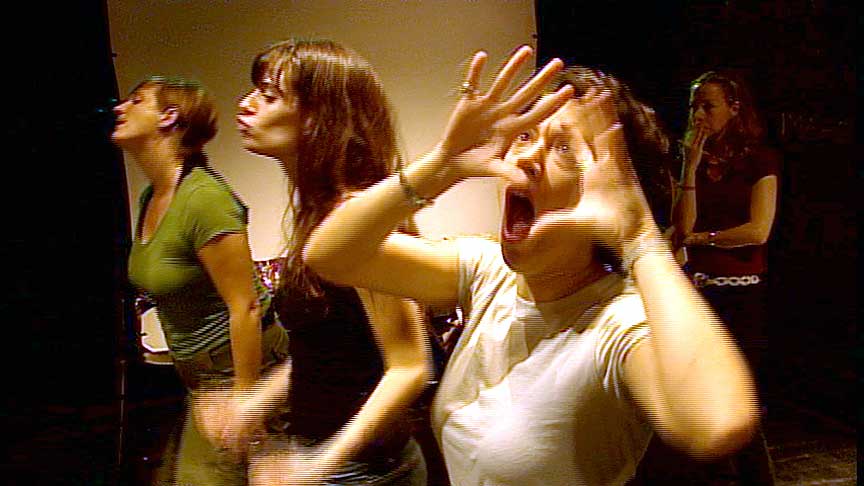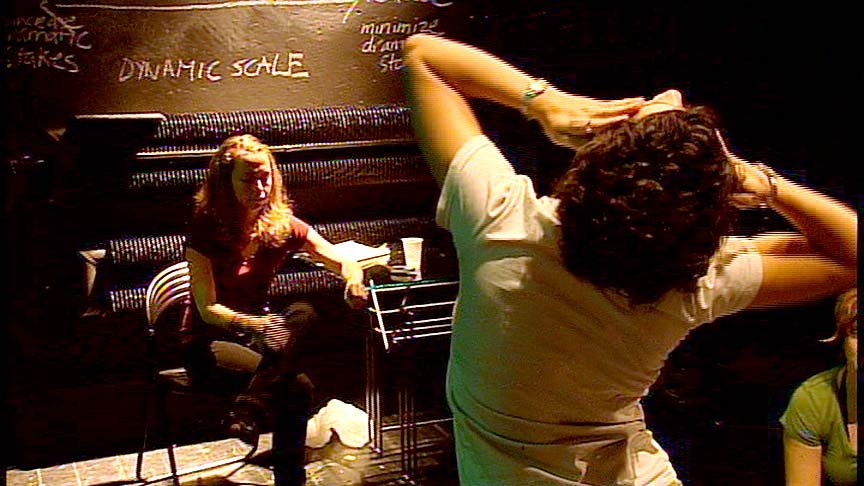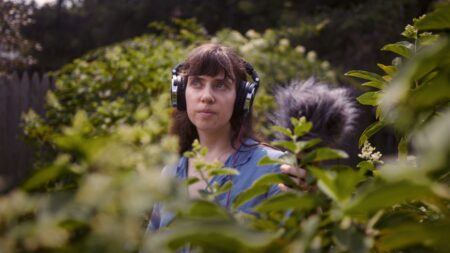Interview
Performance

Production still from the Art in the Twenty-First Century Season 4 episode, Paradox. © Art21, Inc. 2007.
Catherine Sullivan discusses her passion for performance and her 2002 piece Five Economies (big hunt, little hunt).
ART21: When did you start to use film and video in your work, which is heavily involved with live performance?
SULLIVAN: Early on, when I started making theater productions, there were video components mixed in, which I used to spatialize the performance, so that led me to really have a need to start working with film and video. (Spatialization was a device that was very immediate—a way to make a small room or the space of a theater very large, and to suggest other spaces within a small space.) And there was a different kind of performance that grew out of working with the camera. The camera was actually a different kind of audience than a live audience.
I was interested in what kinds of intimacies could be generated—or what other things the performer would do if only the camera were present. And that grew to a different way in which I wanted to look at certain subject matter. In live theater, I really enjoy the pleasure of the eyes to look anywhere and the feeling of a very pleasurable kind of participation—watching and being able to experience a lot of different kinds of spatial compositions and depths. In film, it became more about how the body was interpreted once it was broken down and framed in a series of parts, and then reassembled by me either through editing or the manner in which it was displayed.
ART21: What do you mean by spatialization? It’s a curious word.
SULLIVAN: Some of the early theater works—they were performed in very small spaces, so it was a device that was very basic to develop: to make a small room feel like a very large place. And to suggest other spaces within this small space that could be infinite, really. You could actually use video and the presence of a monitor or projector to create any number of spaces, within that small space.

Production still from the Art in the Twenty-First Century Season 4 episode, Paradox. © Art21, Inc. 2007.
ART21: What is it about the human body, on film or in performance, that’s interesting to you?
SULLIVAN: I was always interested in the body’s capacity for signification. That’s one of the reasons why dramatic acting always interested me—provoking questions about its potential for infinite transformation or asking why certain bodies are prohibited from transforming. Is it that the roles they’re playing aren’t suited to their particular physiognomies, creating some kind of obstruction? Are there other roles they might play, which are suited to their physiognomies, which might set them free?
ART21: How does this play out in your work?
SULLIVAN: In Five Economies (big hunt, little hunt), one actress is engaged with a number of different roles and styles. So, what becomes fascinating to me is that this one person can transform, not only through the roles that she plays but also through the styles through which these roles are filtered. She ends up being a transcendent figure in the piece because she is able to absorb and project such a multitude of codification. Meanwhile, there are other actors in the same piece, who are somehow themselves in every single role and through every different style. Again, that’s fascinating to me: how the same kind of character silhouette, for one person, would be a place of transcendence or transformation but, for another, would be an articulation of immobility, a lack of capacity to transform. The role becomes something that articulates the actor, just as much as the actor articulates the role.
ART21: How did this particular project come about?
SULLIVAN: Five Economies began with several sources: some from film, some from real life, and some from research on popular ritual. The films included Whatever Happened to Baby Jane, Bergman’s Persona, Tim (an early Mel Gibson film), Peter Brook’s Marat/Sade, and The Miracle Worker (the story of Helen Keller). From real life, I took the story of Birdie Jo Hoaks, a twenty-five-year-old woman who tried to pass as a thirteen-year-old boy so she could obtain social services in Utah. The social rituals were games played at wakes in Ireland in the seventeenth and eighteenth centuries.
All these sources or models had to do with the paradox—the strange cultural fixation—that we find pleasure in the misfortunes of others. With regard to the popular films, I was questioning why the ascendance of an actor is expressed through the affliction of a character. Why—in order to demonstrate mastery as an actor—does one have to play someone who’s disfigured, deformed, or psychotic? It’s an odd paradox—that in order to demonstrate one’s craft, one has to do it through that kind of role. I had an acting teacher once who said, “If you can do this—play blindness or disease or psychosis—then as an actor, you’re really hunting the big game.” (And that’s my title, Big Hunt.)
The sources all generated a stylistic economy, through which all of them were then filtered. This formed a series of scenes, a restaging of the sources. So, you have the story of Helen Keller staged in the manner of classic American repertory theater, in a naturalistic manner reminiscent of Ingmar Bergman, and in the noir-ish manner of Whatever Happened to Baby Jane. And you have a permutation of scenes that is derived from the imagined narrative of Birdie Jo Hoaks. So, you have the actors trying to transform, not only through these paradoxical roles but also through constantly shifting styles.
Through research into the nature of social ritual, I discovered the Irish wake amusement, which seemed particularly pertinent because the games were very cruel—by and large about locating a participant as a booby. So, it seemed related, again, to the question “Why do we take pleasure in other people’s misfortunes?” and to the consideration of this kind of cruelty as a basis for the comedic impulse. So, all the sources had to do with that paradox.

Production still from the Art in the Twenty-First Century Season 4 episode, Paradox. © Art21, Inc. 2007.
ART21: Who are some of the actors in this piece, and how do they transform themselves through different roles?
SULLIVAN: There’s one actress in The Five Economies, Jennifer Kingsley, who performs a restaging of The Miracle Worker, the story of Helen Keller. She’s doing the eating scene as Helen Keller and is completely believable in that scene. Then, in another scene, we see her in a kind of Bergman-esque naturalism, again performing the eating scene from The Miracle Worker. To my mind, there she’s really fluid. She’s able to transform, both in terms of the scene itself but also in terms of the manner in which the scenes are portrayed or depicted. To me, that’s fascinating.
There’s another actor that I work with, Michael Garvey, who is a very rugged-looking man with very particular features. He’s put into a series of scenes; and in one of the scenes, he plays a state trooper who has to drag one of the other characters away. In another scene, he’s dressed in a concoction of costume elements, and he’s supposed to be Baby Jane. So, that’s a case where this particular actor has his qualities that are very suited to playing the state trooper but very unsuited to playing Baby Jane.
ART21: Do you think that’s also paradoxical—the ability for one actor to transform, versus another in the work?
SULLIVAN: I would not say paradoxical—I would say the work is concerned with contingencies, things that are impossibly contingent upon one another. That interests me very much.
ART21: What are the kinds of subjects that interest you the most?
SULLIVAN: The kinds of subjects that have always interested me have been those that I have something and nothing in common with. As a foundation for a project, that’s enormously unstable but incredibly interesting because, within that, there’s always a reverse sort of projection onto me. If there’s an aspect of the work—if, for example, we have to make a costume for an aboriginal from the Russian arctic—and we need to make a decision, certainly there’s research we can do to say, “This is what an aboriginal from the Russian arctic looks like.” But sometimes it’s okay if we just guess because it’s the guessing and making of mistakes that then say something about what we don’t know. And that is a kind of truth.
So, there’s an incredible amount of conflict in thinking about some of these things. But, at the same time, to have this imperfect apparatus seems to reveal something about my misunderstanding or my lack of understanding, which is then truthful in some way. To assume that I have something in common with the situation, when I don’t, creates an interesting problematic in the work.

Production still from the Art in the Twenty-First Century Season 4 episode, Paradox. © Art21, Inc. 2007.
ART21: Do these ideas play out in The Five Economies?
SULLIVAN: This relates particularly to Ice Floes of Franz Joseph Land. This was a piece that began with my interest in a hostage crisis in Moscow in 2002, when a faction of Chechnyan separatists stormed a theater. What particularly interested me about that event was that the musical playing in the theater was based on a love-and-adventure novel about polar aviation and the Russian arctic, and that it had aspirations of being a kind of Broadway-spectacle-with-a-Russian-soul. I thought that was painful—that in Russia, where there’s a tradition of theater as spectacle, the aspiration would be toward a Broadway spectacle. But it was this horrific event that I found very compelling, which raised a number of questions—one of which had to do with cultural assimilation. And I looked at the event, as I often do, in terms of its surrounding conditions—not to go to the musical itself or the Chechnyan or Russian situation, but to work with the novel as material I could project onto.
In this work, we started with pantomime—thinking about it as a very reduced form of theater that required the actor to work hard to create a kind of elsewhere, with nothing else around him. These pantomimes were arbitrary. And because they were arbitrary, they could be seen as brutal or mechanized and automatic. The movement style was an analogy for the cultural brutality that was part of the content of the work.
If I look at all the works objectively, I think there are certain interests that I have—in how the body might ultimately engage with a certain kind of mechanization. So, in a general sense, it’s the idea that the movement itself is a kind of mechanized regime that’s impressed upon the actors. And that part of the work is their struggle with it. A lot of that has ended up looking very percussive. It requires very quick transitions between one gesture and another, or often there’s no place for transition. It’s not that I’m trying to create a sense of suffering. That’s not something that interests me. It’s more that the content itself suggests oppressive cultural regimes, to which I would like the movement to be analogous.



